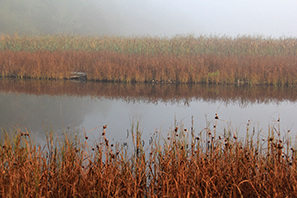 One of the ways you can put nature to work is to maintain a buffer of native vegetation along your bluff or shoreline. Buffers provide a transition between aquatic and upland areas and provide a number of important benefits to you and our waterways. Vegetation helps stabilize slopes and bluffs, and can calm heavy wave action, reducing the need for expensive bulkheads. Along streams, the vegetation in the buffer can help prevent erosion and slow damaging floodwaters. Healthy buffers can protect water quality by filtering out sediment and pollutants such as nitrogen, phosphorus, heavy metals, pesticides, harmful bacteria, and other pathogens common in runoff from streets, homes and agricultural areas. Buffers also provide shade, food sources, and habitat for birds, fish, wildlife and essential insects such as pollinators. Buffers require little in the way of irrigation or maintenance once the plants are established. Additional information on shoreline buffers can be found in Guideline 5 and on streamside buffers in Guideline 6.
One of the ways you can put nature to work is to maintain a buffer of native vegetation along your bluff or shoreline. Buffers provide a transition between aquatic and upland areas and provide a number of important benefits to you and our waterways. Vegetation helps stabilize slopes and bluffs, and can calm heavy wave action, reducing the need for expensive bulkheads. Along streams, the vegetation in the buffer can help prevent erosion and slow damaging floodwaters. Healthy buffers can protect water quality by filtering out sediment and pollutants such as nitrogen, phosphorus, heavy metals, pesticides, harmful bacteria, and other pathogens common in runoff from streets, homes and agricultural areas. Buffers also provide shade, food sources, and habitat for birds, fish, wildlife and essential insects such as pollinators. Buffers require little in the way of irrigation or maintenance once the plants are established. Additional information on shoreline buffers can be found in Guideline 5 and on streamside buffers in Guideline 6.
Maintaining a buffer is not only important in protecting your property, but is also required by current regulations. See Guideline 10 for details on permitting and the Shoreline Management Act, which covers Washington’s marine shoreline and rivers and lakes. Streamside buffer requirements are discussed in Guideline 6.